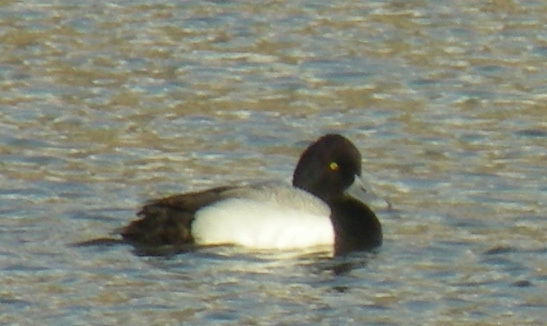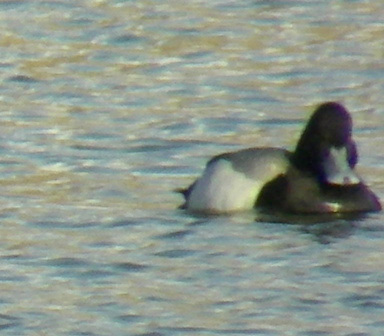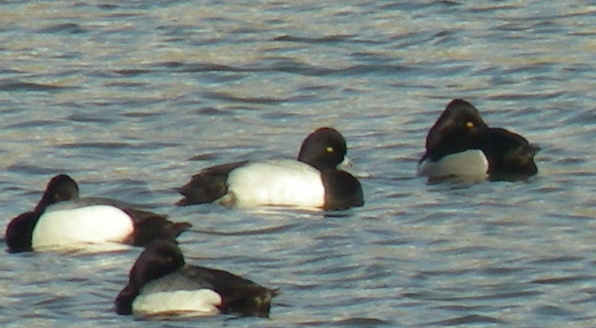|
Summary of Responses
Here is a summary of the seven
responses I got to the three scaup photos
I posted a couple of days ago. First, a bit more background. I
purposely didn't mention it in my post, but photos 1 and 2 showed the
same individual from two different angles. Photo 3 was taken a few
minutes later, and may or may not have shown the same bird, I don't
know. Here are the "votes."
 |
Photo 1 Votes:
6 Greater
1 Lesser |
| |
|
 |
Photo 2 Votes:
4 Greater
3 Lesser |
| |
|
 |
Photo 3 Votes:
6 Greater
1 Lesser |
I thought they were each Greater, so you can add one more vote for
Greater to each of the summaries above if you want to count my opinion.
Most of the seven respondants mentioned the same field marks that I did,
regardless of whether they judged those marks to indicate a Greater or
Lesser. One person mentioned that Greaters have lighter colored backs
than Lessers. Another mentioned that Greaters tend to ride lower in the
water and look broader on the water than Lessers.
The most interesting things to me were: 1) No one implied that they were
100% confident. Everyone tempered their response with some qualifier
like "I believe" or "I think". But perhaps they were just being modest?
And 2) There was a variety of responses even among those people I
consider to be experienced, reputable birders. Clearly this is not an
easy species pair to identify.
Thanks to Craig Fosdick, Keith Archibald, Cliff Weisse, Stephen
Peterson, Buck Russell, Jay Langford, and Eric Huish for contributing
their thoughts. Below are excerpts from their emails, with names
removed, in case you want to read more.
Good birding,
Ryan Ryan P.
O'Donnell
Department of Biology and the Ecology Center
Utah State University
5305 Old Main Hill
Logan, UT 84322-5305
Excerpts from emails:
"I'm on the fence, but I think it probably is a Greater. I just read
Sibley's scaup sidebar in the Big Sibley, and it is not reassuring. I
like the picture showing the scaup looking almost head-on (twds the
observer). The bill looks pretty good in that shot, nice and big and
wide and broad, with a nice big nail, but it would be nice to have a
Lesser Scaup bill next to it. The bird does not have a peaked head, and
the two Lessers (?) sleeping to the left of it apparently do, and they
also have darker more heavily marked backs. So, I think I'm ok with
Greater Scaup. I can see that head color is essentially useless (as
Sibley says), because except for the nearly head-on shot, the head color
of the Greater appears to be the same as the Lessers; some sort of
purple-green."
"I think the scaup in your photos are all Lessers. The highest point on
the head is behind the eye, bill base is less than half the height of
the head (more than half the head height on Greater), "jowls" don't look
that wide in the one front view and the nail looks narrow in the same
shot. Hope this is helpful."
"I believe that is a Greater Scaup, (I think there are at least two in
one of your pics, the other one has
its head underneath its wing), based on the round shape of the head, the
whiter side.
Check out Utahbirds side-by-side comparison."
"I used the same criteria that you listed in your email. I believe that
you have a greater in your photos, but am very curious to read what
others think. What lens are you using on your camera?" [Those shots
were taken with a Pentax W30 digital camera held up to the eyepiece of a
Nikon Sky and Earth spotting scope with a 20x eyepiece.]
"Photo 1: appears to be GREATER with rounded head. Whitish body lacks
heavier, coarser barring of LESSER. Photo2: possible peaked crown
indicates LESSER? Photo3: (from left to right) #1 difficult to ID.
#3; GREATER. #4; LESSER. Based on comparing head profiles. Also, #3
appears to have whitish body which #4 lacks, but this could be due to
the light/angle of photo."
"I agree with [the previous author] on the ID. But I think bird #4 in
photo #3 is a Ring-necked Duck and the two on the left Lesser Scaup."
|


